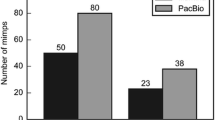Abstract
The transposable element impala is a member of the widespread superfamily of Tc1-mariner transposons, identified in the genome of the plant pathogenic fungus Fusarium oxysporum. This element is present in a low copy number and is actively transposed in the F.␣oxysporum strain F24 that is pathogenic for melons. The structure of the impala family was investigated by cloning and sequencing all the genomic copies. The analysis revealed that this family is composed of full-length and truncated copies. Four copies contained a long open reading frame that could potentially encode a transposase of 340 amino acids. The presence of conserved functional domains (a nuclear localisation signal, a catalytic DDE domain and a DNA-binding domain) suggests that these four copies may be autonomous elements. Sequence comparisons and phylogenetic analysis of the impala copies defined three subfamilies, which differ by a high level of nucleotide polymorphism (around 20%). The coexistence of these divergent subfamilies in the same genome may indicate that the impala family is of ancient origin and/or that it arose by successive horizontal transmission events.
Similar content being viewed by others
Author information
Authors and Affiliations
Additional information
Received: 2 December 1997 / Accepted: 28 April 1998
Rights and permissions
About this article
Cite this article
Hua-Van, A., Héricourt, F., Capy, P. et al. Three highly divergent subfamilies of the impala transposable element coexist in the genome of the fungus Fusarium oxysporum . Mol Gen Genet 259, 354–362 (1998). https://doi.org/10.1007/s004380050822
Issue Date:
DOI: https://doi.org/10.1007/s004380050822




